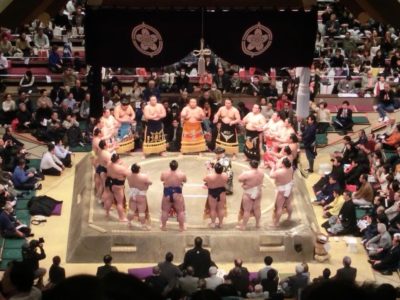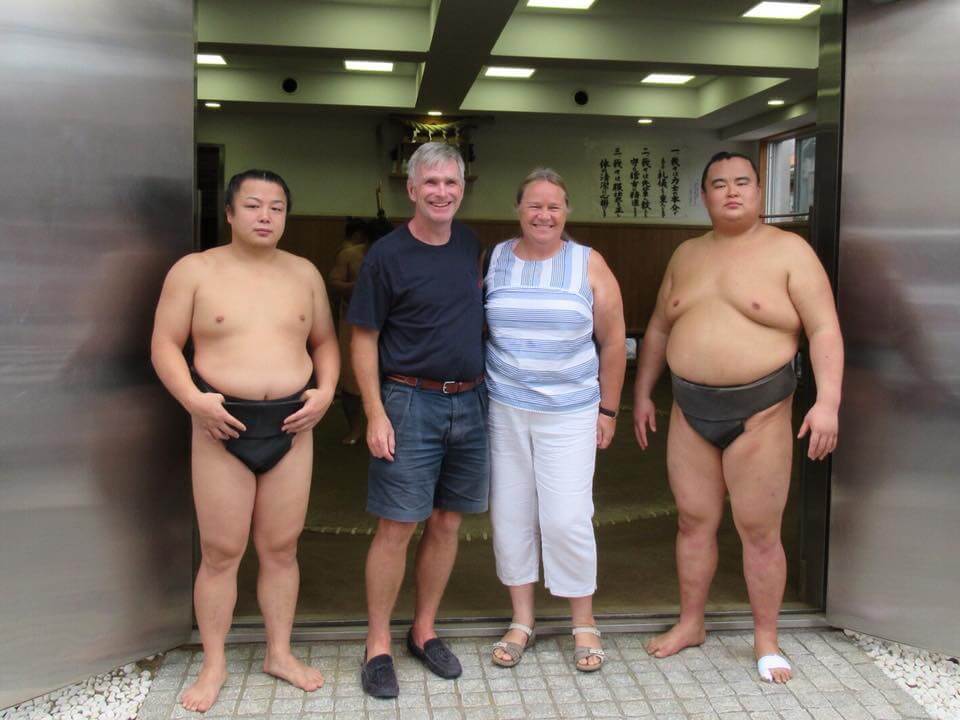While the name of this Tokyo neighborhood might not sound familiar to you, you will definitely have heard of the sport that makes Ryogoku special. This place is the epicenter of sumo wrestling, as you can find the Kokugikan Sumo Stadium here as well as numerous sumo stables where the wrestlers are raised. Why should you put Ryogoku on your Tokyo itinerary?

A Short History of Sumo
The history of sumo wrestling goes all the way back to the 3rd century when it was performed as a part of a Shinto ritual to pray for a good harvest that year. From the 8th-century, sumo bouts were performed in front of the Emperor, and later on, samurai families also liked having sumo wrestlers to protect them and held tournaments to see them fight.
The sumo sport as we know it today is the form from the Edo period. Where sumo used to be enjoyed only by the nobility, it became a spectator sport for everyone during this time. Rules were set in place to appease the Edo government, and sumo stables were created to properly raise the wrestlers. Even today, the way they dress, wear their hair, and perform ceremonies goes all the way back to the Edo period, making sumo an important part of Japanese cultural heritage.
Sumo Stables
If you want to become a wrestler the minimum requirement is to be at least 1.67m tall and weigh 67 kg. Once you meet those requirements, you can just contact a sumo stable and ask them if you can join. If you are foreign you have to ask a stable that doesn’t currently train a foreigner yet, as the rules say that each stable can only train one foreigner at the same time. You usually have to do a short trial period to see if you are cut out for the sport.
Life in a sumo stable is generally quite tough, there is a very strict hierarchy, and if you were the last one to join you will get all the menial tasks that nobody else wants to do. You also don’t have much of a private life, and of course, your life will revolve around training, eating, and fighting in matches. Only if you rise in the ranks by winning important matches, you will get more privileges.
Watching Sumo Wrestling
There are over 20 stables in Ryogoku alone, and some of them do accept visitors to the morning practice. You can’t just walk in and need a reservation that can usually only be made in Japanese. We can help you arrange a visit to a sumo morning practice during your Japan tour, so you can really see this majestic sport from up close and have a very personal experience. If you only want to have a quick look, you can watch the morning practice from behind the outside window for free at Tokyo Arashio Beya. Please adhere to their rules if you go there.
If you travel to Japan at the right time, you might also be able to catch a match in a grand tournament. The grand tournaments in Ryogoku are held in January, May, and September, and there are tournaments in Osaka in March, in Nagoya in July, and in November in Fukuoka.
Tickets are valid for a whole tournament day, which lasts from 8.30 am until 6 pm. The lower-ranked wrestlers will come out first, while the leaders of the ranking will come out in the afternoon. You don’t have to stay the whole time, and you can enter and exit as you please.
Buy Sumo Tickets
Please note that the best seats tend to sell out quickly once the tickets go on sale, especially the tickets for one of the final tournament days can be sold out within minutes. If you want to be sure to get the best tickets on the day that suits your travel schedule best, we can help you secure them. If you are OK with seats that are further away from the stage and/or one of the first tournament days, it is usually not too hard to buy sumo tickets yourself. You can even show up on the morning of the match itself and stand in line at the stadium for a chance of buying the cheapest tickets available.
Another way to see sumo wrestlers in action is to see them on one of their tour events. In the off-season, the wrestlers are giving free to watch demonstrations all over the country, so if you are lucky you might be able to catch one of these demos during your Japan tour. You can see their tour schedule on the official sumo website.
What to Eat in Ryogoku
If you would like to eat what sumo wrestlers eat, Ryogoku is the perfect place to do so. Some wrestlers open restaurants after their sumo career is finished, where they often serve chanko nabe. Chanko nabe is the hot pot filled with seasonal vegetables like carrots, mushrooms, and cabbage, and of course, lots of protein such as chicken meatballs, fishballs, tofu, and pork as this is the dish that makes sumo wrestlers big.
No worries, after eating chanko nabe in the amounts you get at the restaurant you will not get fat right away as that takes a much larger amount and a standard nap after eating, and it is actually quite a healthy dish. One of the best-known Ryogoku restaurants to go to if you want to try chanko nabe is Chanko Tomoegata. If you need help with making a reservation, our concierge service will be of great use.
Sumo Stadium and Sumo Museum
The sumo stadium itself is not always accessible to the public, it depends on the day and time you go. Sometimes there are free events that everyone can enter, but if there are matches going on you need to have or buy a ticket. Tickets can be bought on the official sumo website, through agents, and also at the door if you don’t mind taking a chance and standing in line.
The sumo museum is free to enter, and a fun little place to check out if you happen to be around. You can see many pictures of former sumo champions, their handprints, and some other sumo paraphernalia.
Other Places of Interest in Ryogoku
The Former Yasuda Garden is a small Japanese landscape garden that you can enter for free. It is a nice place to take some photographs of a typical Japanese garden, flora and fauna. It was the first private garden that was given to the city to be opened to the public in 1922. After having been ruined by the earthquake of 1923 and WW2, it was completely renovated and opened again in 1971. The garden has retained much of its original style and is similar to the more famous Kiyosumi gardens.
Another green space that is tied to the history of the area is Yokoamicho Park, which is the location of a great tragedy in the aftermath of the 1923 earthquake. Many people died in the firestorms that were raging through Tokyo in the days after the earthquake after they fled to this mainly empty piece of land.
There is a large memorial hall where the victims’ remains are stored, which were later joined by more remains of people who died during the air raids of Tokyo in 1945. Also in the park is a museum that is freely accessible and has pictures, remains of people’s possessions, and English text that tells of the horrors that have plagued Tokyo in the early to the mid-20th century.
Ryogoku Museums
Museum-lovers should definitely not skip out on Ryogoku if they are in Tokyo, as this area boasts 3 major museums. Firstly, the Edo Tokyo Museum is not only for history buffs but for anyone young or old who wants to learn more about Tokyo history with impressive visuals and interactive exhibitions.
The Sumida Hokusai Museum is very English-friendly and a must for anyone with an interest in Japanese art and ukiyo-e in particular. For those who love everything related to samurai and swords, the Japanese Sword Museum is a real treasure chest, but it is definitely one of those museums that are mainly of interest to the real fans of the main subject.
Your Japan Tour
As seasoned Japan experts, we can help you create your perfect Japan tour including destinations like Tokyo and Ryogoku. Contact us to start planning your unforgettable holiday to this fascinating country full of once-in-a-lifetime experiences, culture, history, nature, and delicious food!
